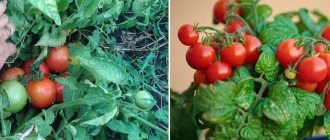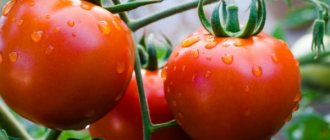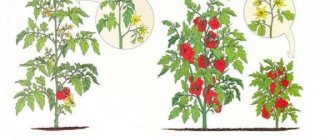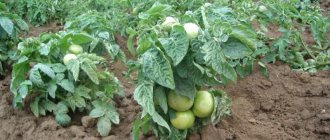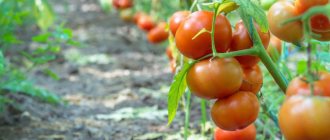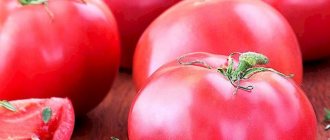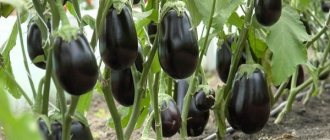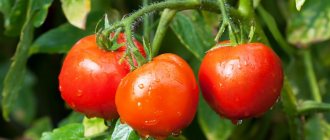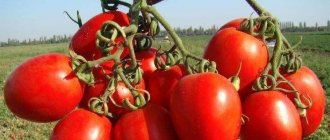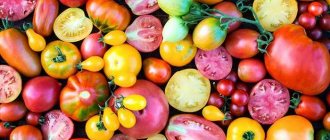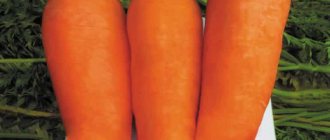- Multi-colored tomatoes
- Early tomatoes
- Mid-late tomatoes
- Let's talk about the rest
It seems as if only yesterday a tomato bush appeared in Russia, which was perceived as some kind of curiosity, just as a thick book could become a description of only those cultivars that are suitable for cultivation in central Russia. It is very easy to get confused in this variety of varieties, but every detail must be taken into account - the vigor of the bush, susceptibility to pests and diseases, to environmental conditions, color and, finally, taste. Let's look at the most successful, from my personal point of view, varieties that are ideal for growing in central Russia.
List of late-ripening tomato varieties, with detailed descriptions of characteristics
Typically, summer residents give preference to early varieties of tomatoes - after all, the crop harvested at the beginning of summer is expensive, and therefore more profitable for trade.
And after a long winter, everyone wants to quickly enjoy their own, organic vegetables. But late-ripening tomato varieties also have their advantages, characterized by a sweet, rich taste and aroma. In addition, they are more diverse and interesting to grow.
In this section we will tell you about all the late-ripening varieties of tomatoes that we know about. You will get acquainted with their descriptions, main characteristics and features of agricultural technology.
Cherry tomatoes
Cherry is another “special” variety of tomato. These are small tomatoes weighing on average 15-25 g with a pleasant sweet taste and juicy pulp. They are named after the cherry (“cherry” in English) for their modest size.
They are grown in the same way as regular tomatoes. True, given the small size of the bush, they are also excellent for planting in containers.
These tiny tomatoes are added to salads and used in snacks. However, there are varieties of cherry tomatoes suitable for canning .
Most often, cherry fruits are red in color, but there are also varieties of white, yellow, and black tomatoes.
Popular varieties and hybrids of cherry tomatoes: Balcony Miracle, El F1, Cranberry in Sugar, Cherry Paint, Cherry Quirino, Savva, Little Star F1, Negro F1, Lisa F1, Lycopa F1, Blossem.
What are late-ripening tomato varieties?
The time period from planting a seed to the ripening of the fruit is called the growing season.
In late-ripening tomato varieties, it lasts more than 120 days. For example, the late-ripening variety Giraffe ripens from 140 to 160 days, Ox Heart from 125 to 132 days, and Titan begins to bear fruit only 130 days after planting.
Thus, late-ripening tomato varieties are those whose growing season is 120 days or more from the date of planting.
All tomatoes are heat-loving and need sun, as well as regular watering and care; moreover, they react sensitively to temperature imbalances.
Due to this fastidiousness, growing late varieties, especially in open ground, is more suitable for the southern regions . Although, some varieties of late tomatoes are frost-resistant.
On our website you will find many useful articles about a wide variety of late-ripening tomato varieties. For your convenience, we have collected some of the links into a general table:
Table of late-ripening tomato varieties:
What type are they?
Late-ripening tomatoes are most often indeterminate. This means that such bushes grow throughout the entire growing season. These varieties are tall and can reach two meters or more in height.
For example:
- The Giraffe variety reaches a height of 1.8 meters or more.
- De Barao Giant is a vigorous bush, reaching 4 meters in height.
- Cosmonaut Volkov stretches up to 2 meters in height.
However, among the late-ripening varieties of tomatoes you can also find a determinate type, whose bushes are limited in growth.
For example:
- Rio Grand variety - reaches from 0.7 to 1 meter.
- Titan grows up to 40 cm.
How to grow seedlings correctly?
Seeds of late-ripening tomatoes are sown in the ground 55-65 days before planting in open ground or a greenhouse.
Since the first shoots appear quite quickly - 5-10 days after sowing, the period for keeping plants on the windowsill (or in a special room) is 45-60 days from the moment the shoots appear.
Why is this important to remember? Overexposure of seedlings is fraught with a decrease in yield due to oppression of the bush.
The average time for sowing tomatoes is as follows::
- in the southern regions of Russia - from the 20th of February to March 15 (planting in open ground - from April 15 to May 20);
- in the central regions of Russia - from March 15 to April 1 (planting in open ground - from May 10 to early June);
- in the northern regions (Siberia, Ural) - from April 1 to 15 (planting in open ground - from May 25 to June 15).
If you plan to plant tomato seedlings not in open ground, but in a greenhouse or on a glassed-in balcony, then sowing work can begin 2-3 weeks earlier.
When growing tomato seedlings, seedlings need the following conditions:
- a large amount of light; if there is a lack of natural light, artificial additional lighting with lamps is required;
- high humidity - spray tomato seedlings 1-2 times a day, use air humidifiers;
- warm – during the day the optimal temperature for tomato seedlings is 18-25°C, at night – 12-15°C.
Subtleties of care
To grow a decent harvest, you must follow the rules for caring for tomatoes:
- Regularly take measures to combat parasites, loosen the soil and feed it, remove unnecessary stepsons in a timely manner.
- To maintain the air-water and temperature balance of the fruit, the soil in the beds should not become crusty. To do this, it is enough to use mulching - cover the soil with humus, straw or peat.
- A couple of weeks after planting tomatoes in the garden, they need to be fed with the following solution: 10 g of the mineral fertilizer ammonium nitrate and 15 g of the chemical fertilizer superphosphate are diluted in 10 liters of water.
- After the first ovaries appear, the tomatoes are treated with a solution: 10 g of ammonium nitrate and 15 g of potassium sulfate per 10 liters of water.
- To get an excellent harvest, you can use a concentrate of organic fertilizers: a mixture of bird droppings and water.
Features of late-ripening varieties
Late-ripening varieties of tomatoes are particularly juicy, fleshy, aroma and taste. They come in different shapes and weights: from small to giant, from light to very heavy. It is late tomatoes that can be grown without the use of seedlings - the seeds are sown directly into the soil in a permanent place (in hot regions!).
Some varieties of late-ripening tomatoes are resistant to various diseases: verticillium blight, fusarium blight, cladosporiosis. Late tomato hybrids have good resistance to nematodes, tobacco mosaic virus, cladosporiosis, fusarium and other diseases.
Late-ripening tomato varieties for growing in greenhouses:
- Russian size is a variety of indeterminate type, reaching 180 cm in height. It is characterized by high yield - 4-4.5 kg can be harvested from one bush. The ripe fruit is red in color and its weight varies from 650 g to 2 kg. It is grown only in a greenhouse or under film.
- King of Kings is a tall variety, 1.5 to 2 m in height. It is a complex hybrid. The time period from sowing seeds to harvesting is 110-120 days. It has high yields - up to 5 kg are harvested from one bush. Resistant to late blight.
- De Barao is an indeterminate plant, reaching 4 m. Oblong tomatoes weigh approximately 100 g. A distinctive feature of the variety is its high frost resistance. It bears fruit until the onset of frost.
- Premier is a hybrid variety of indeterminate type with good yield. One square meter of planting can produce up to 9 kg of fruit. The height of the bushes is 110-120 cm.
- Rocket is an unpretentious low-growing tomato variety, with a height of 50 to 70 cm. The fruits are small and have an elongated shape. Their weight is no more than 40 g. They are distinguished by their ability to be stored for a long time.
- Altai is a high-yielding late hybrid of indeterminate nature, reaching about 150 cm. The flat-rounded fruits ripen on clusters of 4-6 pieces.
- American ribbed is a medium-sized plant from 120 to 150 cm. Tomatoes have an original appearance and weight from 150 to 250 g. Endowed with resistance to disease.
The most productive and popular late-ripening tomato varieties among gardeners are:
- Bull's heart is a tomato hybrid beloved by gardeners, growing up to 2 m in height. Fruit weight is about 400 g. It is quite resistant to diseases and insect pests.
- Yusupovskie is a tall, strong variety. Growing in open soil it reaches a height of up to 80 cm, in a greenhouse - up to 160 cm. The weight of ripe tomatoes ranges from 200 to 800 g.
- Grapefruit is an indeterminate tomato with amazing taste and impressive size. Capable of growing up to 2 m. Fruit ripening period is about 180 days. Has enhanced disease resistance.
- Bobcat is a determinate hybrid with a height of 50 to 70 cm. It withstands major tomato diseases. On average, you can collect 4-6 kg of fruit from one square meter.
- Brown sugar is a tall, dark-fruited variety with good yields. Can be grown both in greenhouses and in open soil. Bushes can grow up to 2.5 m. The weight of perfectly round fruits varies from 120 to 150 g. Endowed with increased cold resistance and resistance to pests and diseases.
Read also: Raspberries of the Patricia variety: description, planting and care, reviews
Late-ripening tomato varieties have an amazing taste and can grow both in open ground and in greenhouses. They are characterized by strong resistance to diseases and the ability to be stored for a long time, which makes them in demand among gardening enthusiasts.
Review of late varieties of tomatoes for open ground
Late-ripening tomato varieties are considered to be crops that bear fruit 4 months after seed germination. Typically, in a garden, up to 10% of the plot in a garden bed intended for the general cultivation of tomatoes of different ripening periods is allocated for late tomatoes.
Brown sugar
The unusual color of the tomato is considered medicinal. The substances contained in the pulp help the human body fight cancer and cardiovascular diseases. Medicinal properties are present only in freshly squeezed juice. For regular consumption, the vegetable is used in canning and other types of processing.
The stems of the plant are tall and are not able to support the weight of the fruit on their own, so they are fixed on trellises. Tomatoes grow in a regular round shape, weighing up to 150 g. The full maturity of the fruit is determined by the dark brown color of the pulp. Sometimes the skin may take on a burgundy tint.
Sis F 1
This hybrid will appeal to lovers of medium-sized fruits, convenient for canning in jars. The maximum weight of a ripe tomato reaches 80 g. The vegetable is slightly elongated, and there is slight ribbing along the walls. The harvest ripens no earlier than after 4 months. Picked tomatoes can be stored for a long time, but it is better to keep them indoors. In the cold, for example, in the refrigerator, the vegetable deteriorates its taste.
Advice! The hybrid is characterized by good fruiting in all weather conditions. The crop is recommended for risky farming areas.
Octopus F1
The hybrid was bred by breeders as a tomato tree. In industrial greenhouses, the plant reaches enormous sizes and bears fruit for a very long time, bearing up to 14 thousand fruits. The tree will not grow in open ground, but the result will be an ordinary tall tomato. The plant will need at least twice a day of feeding and tying to the trellis. Tomatoes are formed in clusters. Fruit ripening begins 4 months after germination. The advantage of the hybrid is its resistance to viruses when grown outdoors.
De Barao
The variety, which has long been popular among gardeners, has several subspecies. The characteristics of tomatoes are almost the same, only the color of the fruit differs. It is very convenient to grow your favorite tomato on the plot, for example, with yellow and pink fruits. Typically, vegetable growers plant 3 bushes that produce tomatoes of different colors. The stems of the plant are very long, and if the tops are not pinched, they can grow up to 4 m in height. To tie them up you will need a large trellis. Ripe fruits are small, weighing a maximum of 70 g, which makes them popular for whole preservation in jars.
Lezhky
By the name of the variety you can judge the possibility of long-term storage of tomatoes. The collected unripe fruits will arrive in time for the New Year holidays. The plant bears fruit well in open ground, producing 7 fruits in each cluster. The maximum height of the bush is 0.7 m. Fruits with strong skin and dense pulp do not tend to crack. The weight of a mature vegetable reaches 120 g.
Khutorskoy salting
Every housewife will like tomatoes of this variety, as they are ideal for pickling and canning. Even after heat treatment, the skin of the fruit does not crack, and the flesh retains its density and crunch, unusual for a tomato. Orange fruits weigh about 110 g. Using as a secondary crop, tomato can be planted after harvesting greens, early cucumbers or cauliflower. The indeterminate bush grows up to 2 m in height. From 1 m2 of open bed you can get up to 7.5 kg of harvest.
Cosmonaut Volkov
You can get the first fruits from the plant after 115 days. This defines the tomato as being closer to mid-late varieties, but it can also be called late. Several bushes of this variety are planted in the home garden, since its fruits are only intended for salad purposes and are not used for canning. The plant, 2 m high, grows powerful, but practically not spreading. The main stem is tied to the trellis, and the excess stepsons are removed. The ovary is formed in clusters of 3 tomatoes each. Ripe tomatoes are large, sometimes reaching a weight of 300 g. During the season, the bush is capable of producing 6 kg of tomatoes. The walls of the vegetable have weak ribbing.
Rio grand
Like all late tomatoes, the crop is ready to produce its first ripe fruits after 4 months. The plant is considered determinate, but the bush is very developed and grows up to 1 m in height. The shape of the fruit resembles something between an oval and a square. A mature tomato weighs about 140 g. The crop does not require special care and easily tolerates temperature fluctuations. The vegetable is used in different directions and tolerates transportation well.
Titanium
A low-growing crop will delight you with the first tomatoes only after 130 days. A determinate plant will grow to a maximum height of 40 cm. Red fruits grow evenly round, weighing up to 140 g. Smooth skin with dense pulp does not crack. The vegetable is delicious in any form.
Date fruit
The variety will attract the attention of lovers of very small tomatoes. Small, slightly elongated fruits weigh only 20 g, but in terms of taste they can compete with many southern varieties. From a distance, a tomato looks a little like a date. The yellow pulp is highly saturated with sugar. The plant is powerful; the formed clusters bear a maximum of 8 fruits.
Scorpion
The tomato variety is adapted for cultivation in open and closed ground. The tall plant bears beautiful raspberry-colored fruits. The tomato has a classic round shape, the area near the stalk and opposite it is slightly flattened. The fruits grow large, some specimens weigh up to 430 g. The dense pulp contains few grains. The crop is famous for its stable fruiting and high yield.
Bull's heart
The traditional representative of late tomatoes will bear fruit in 120 days. The main stem grows up to 2 m in height, but the plant itself is sparsely covered with foliage, which allows sunlight and fresh air to penetrate inside the bush. Thanks to this, the crop is less susceptible to late blight. Like all tall tomatoes, the plant needs to be secured to a trellis and pinched. Very large heart-shaped fruits grow weighing 400 g. Tomatoes weighing up to 1 kg can ripen on the lower tier. Due to its large size, the vegetable is not used for canning. Its purpose is salads and processing.
Giraffe
This variety will need at least 130 days to please the grower with ripe tomatoes. The tall bush is capable of bearing fruit in open and closed plots of land. The stem itself will not be able to support the entire mass of the crop, so it is tied to a trellis or any other support. The color of the fruit is somewhere between yellow and orange. Maximum weight 130 g. During the entire growing season, about 5 kg of tomatoes are plucked from the plant. The vegetable can be stored for six months.
Supergiant F1 XXL
The hybrid will appeal to lovers of large tomatoes. The plant can bear gigantic fruits weighing up to 2 kg without special care. The value of the hybrid is only in the taste of the tomato. The sweet, fleshy pulp can be used to make juice and a variety of fresh dishes. Naturally, the vegetable is not suitable for canning.
Finish
A tomato is considered fully ripe at the beginning of the 5th month. Culture is considered determinant. The bush grows up to 75 cm in height, the stem and side shoots are sparsely covered with foliage. The red, dense flesh is covered with a smooth skin, on which an orange tint is visible. Round tomatoes weigh only 90 g. Stable fruiting is observed throughout the entire growing season.
Cherry
A decorative variety of tomatoes will decorate not only the area near the house or balcony, but even winter storage. Small tomatoes are rolled whole into jars without picking them from the bunch. Very sweet fruits weigh only 20 g. Sometimes specimens weighing 30 g are found.
Snowfall F1
The hybrid produces a harvest after 125–150 days. The plant is indeterminate, although the height of the bush does not exceed 1.2 m. The crop is not afraid of sudden changes in temperature, and is able to bear fruit until the end of November until stable frosts occur. The yield is up to 4 kg of tomatoes per plant. The round, dense fruits do not crack, the maximum weight is 75 g. The hybrid has taken root well in the Krasnodar region.
St. Andrew's surprise
The plant has a high main stem up to 2 m. Tomatoes grow large, weighing 400 g. Even larger tomatoes weighing up to 600 g can grow from below on the plant. The indeterminate culture is weakly affected by common diseases. Despite the abundance of juice, the pulp does not tend to crack. The vegetable is used for processing and making salads.
Long keeper
Bushes of this late variety grow to a maximum of 1.5 m in height. Round, slightly flattened tomatoes weigh about 150 g. The crop is grown in open ground, but you won’t be able to wait for ripe fruits on the plant. All tomatoes are picked green in late autumn and stored in the basement where they ripen. The only exception may be the fruits of the lower tier, which manage to acquire a red-orange color on the plant. The yield indicator is 6 kg per plant.
New Year
The plant grows up to 1.5 m in height. The first tomatoes ripen on the lower clusters no earlier than September. The yellow fruits are usually round, sometimes slightly elongated. A mature vegetable weighs no more than 250 g, although specimens weighing 150 g are more common. A fairly high yield allows you to get up to 6 kg of tomatoes per plant. Harvesting of the entire harvest begins in the third ten days of September. All semi-ripe vegetables are stored in the basement, where they ripen.
American ribbed
The standard crop will please the vegetable grower with a harvest in about 125 days. A determinate plant is rarely affected by the main types of diseases. The red fruits are strongly flattened, with characteristically pronounced ribs on the walls. The average weight of a mature tomato is about 250 g, sometimes larger specimens weighing up to 400 g grow. There are up to 7 seed chambers inside the pulp. Ripe tomatoes cannot be stored for long periods of time; it is better to immediately put them into processing or simply eat them. The bush is capable of producing up to 3 kg of vegetables. If you adhere to a planting density of 3 or 4 plants per 1 m2, you can get 12 kg of harvest from such a plot.
Important! The fruits of this variety are prone to severe cracking. To avoid this problem, you need to reduce the frequency of watering. When spotting appears on the leaves of a plant, the best medicine for a tomato is “Tattu”.
This video talks about American varieties of tomatoes:
Altai F1
Fruit ripening in this hybrid is observed after 115 days. The indeterminate plant grows up to 1.5 m in height. The bush is medium covered with large dark green leaves. Fruit set occurs in clusters of 6 tomatoes each. The fruiting period is long until the onset of the first frost. The average weight of a ripe vegetable is about 300 g, but larger fruits weighing up to 500 g are found. The tomatoes are slightly flattened, smooth on top, and faint ribbing appears near the stalk. Inside the pulp there can be up to 6 seed chambers. The skin of the vegetable is quite thin, but so strong that it protects the pulp from cracking. The hybrid has several varieties, differing in the color of ripe fruits: red, pink and orange.
Variety of pink tomato varieties
Pink tomatoes are especially popular among gardeners; varieties of these tomatoes are rich in vitamins and nutrients.
Therefore, pink tomatoes are in some cases better than regular red ones. Pink tomatoes are less demanding to care for and more resistant to weather conditions than red ones. According to the time of ripening, pink vegetables, just like red ones, can be divided into 3 main groups:
Early varieties
Tomatoes belong to this variety if their ripening period does not exceed 90-100 days. The Pink Honey tomato variety is especially popular among gardeners. It has a sweet and delicate taste. These tomatoes have virtually no seeds. As a rule, the first vegetables weigh the most, sometimes their weight reaches 1 kg, subsequent tomatoes do not weigh more than 300-400 g. With proper care during the season, the bush can produce a harvest of about 6 kg. Pink honey can be grown in garden beds and greenhouses. It is drought and disease resistant. Plant height is about 60-70 cm.
Early varieties include Pink Spam. Fruit ripening period is 95 days. Average weight is about 250-300 g. Tomatoes taste very sweet. They tolerate transportation well. Perhaps the only drawback is the high cost of seeds.
Lovers of pink tomatoes should pay attention to Pink Flamingo. These are tasty and aromatic tomatoes. The advantages include their versatility and presentation. Can be stored for 2 months. The first tomatoes are harvested 90 days after planting. If you want to get a good harvest, you should water the bushes daily. Dense planting will negatively affect the size and number of grown tomatoes. The pink flamingo is weather resistant, but very picky about soil.
The miracle of the earth is another early variety that, perhaps, has no drawbacks. The first tomatoes ripen in 90 days. They are very sweet and heart shaped. The height of the bush reaches 1 m. The miracle of the earth is drought-resistant and almost always produces a good harvest.
Among the early-ripening tomatoes, gardeners fell in love with the Early Love . Ripening period is from 95 to 100 days. The fruits are round and slightly flattened on top. The weight of one fruit is 300-400 g. Seedlings can be planted densely, about 5-6 bushes per 1 m². Early love does not require special care and does not need regular watering. The bushes do not need to be tied up. The soil should be loosened from time to time to improve oxygen access to the root system.
Exotic varieties include Arctic . The average weight of tomatoes is about 15 g. Arctic tomatoes are resistant to adverse weather conditions and are not picky about soil. The height of the bush does not exceed 50 cm.
Ground varieties of tomatoes for Central Russia
These include plants that can tolerate late frosts, lack of sun and fairly severe cold in winter. Typically, such crops are quite demanding on fertilizers, but not always.
Alpatieva 905 A
Obtained 50 years ago, but remains enduringly popular. The plant tolerates cold well and can ripen even in partial shade. Brief cold spells and frost on the soil do not affect the yield, so it is excellent for growing in open ground.
From 1 sq. m. you can remove up to 5–6 kg of fruit. The tomatoes are red, round, and their weight does not exceed 110 g. However, they are very tasty and are excellent for winter preparations. The bushes of the crop are low - no more than 30–40 cm, determinate, easy to care for, since they do not require either garter or pinching. In the photo - Alpatyeva 905 A.
Keg F1
A hybrid that is considered the best option for central Russia when grown in open ground. The tomato received this title for its stable, rich harvest, practically independent of frost and low summer temperatures - at least 8 kg per 1 sq. m.
Barrel F1 is interdeterminate, so the bushes need pinching and support. The tomato is an early ripening one - it ripens 90–100 days after planting. The tomatoes are small - 75-100 g, but there are a lot of them in the bunches and they ripen together. In addition, the fruits are distinguished by excellent keeping quality and transportability. And thanks to their small size, they are also ideal for salting.
Mid-season varieties
The Abakan variety was brought from Altai. Some gardeners compare it to the Bull's Heart. The first tomatoes ripen on the 110th day. The average weight is 250-300 g. The tomatoes taste juicy, with a characteristic sourness. The height of the bush is approximately 50-60 cm. Such tomatoes can be planted both in open ground and in a greenhouse. Dense planting is not recommended.
Lovers of pink varieties will definitely have several beds of the Pink Giant in their garden. It is characterized by tall bushes; if they are not pruned, they can grow up to 4-5 m. The average weight of a tomato is 300-400 g. In rare cases, you can find a 2 kg specimen. Since the bushes are tall and the fruits are large, they should be tied up securely. This variety is usually not used for preservation. The only drawback of the Pink Giant is that it has few seeds, so for subsequent planting, take care of the seeds in advance.
Read also: How to grow cucumbers on a windowsill in an apartment in winter: when and how to plant seedlings, feeding, transplanting and caring for grown plants
Mazarin is not inferior in its taste and correct form to many other varieties. The first fruits will ripen in 110-115 days. Mazarin is versatile and great for preservation. So that tomatoes can reveal their taste, it is better to plant the bushes in a greenhouse. The plants are tall and need staking. The peculiarity of Mazarin is its watering. Before flowering, the watering regime is standard, but during the flowering period it is necessary to water if necessary.
Late varieties
Among late-ripening vegetables, perhaps the most common is De Barao pink. The ripening period is 3.5-4 months, so they need to be one of the first to be planted. Vegetables have a neat oval shape. Great for canning. Due to the powerful root system, the bushes are resistant to pests and other diseases. There is no need to water too often. With proper care, you can harvest up to 4 kg of harvest from one bush.
The largest late variety is considered to be Wild Rose. The average weight of a tomato is 500-600 g; in rare cases, you can find a specimen weighing up to 1-1.5 kg. One bush produces about 6 kg of harvest. Wild rose is picky about the soil; it should be loose, nutritious and slightly salted. These tomatoes do not tolerate drought, so make sure to water regularly.
Pink Bobcat tomatoes ripen 115-120 days after seed germination. Fruits weighing up to 300 g, slightly flattened on top. The advantages of Bobcat include resistance to weather conditions and drought. To improve the taste and juiciness, the bushes need to be constantly fertilized.
Tested by gardeners, Sugar Bison is not inferior to all other pink tomatoes. The fruits are large, heart-shaped, the pulp is sugary. The average weight of one is about 500-600 g.
When choosing one variety or another, remember that pink tomatoes will reveal all their advantages only with proper care.
Due to their high sugar content, they require more watering and mineral fertilizers than red ones. Do not allow excessive dampness or excessive drought, this will negatively affect the yield. By following simple rules of agricultural technology, you can get a good harvest in any area.
Early tomatoes
Anything from earlier? Yes please! I recommend Nastenka, Totem, Ephemeral, Winter Cherry, Tsar Bell
and
Explosion
.
Nastenka
is always on my site.
Height is about 70cm, no pinching required, fruits up to 300g, what else is needed? Totem
- height about 50 cm, fruits like a healthy chicken egg, painted red.
It can even grow in the shade, which is why it “lives” near the fence. Efmer
- as if he is afraid of being late and paints his fruits scarlet before others.
The weight of the fruits of this variety is about 100 g - not much, but stable. Winter cherries
- fruits weigh more than 100 g, are small in height, no pinching is required, the color is dark crimson, the taste is wonderful.
Tsar Bell
- fruits suitable for a royal table, weighing 700 g each, bright scarlet, slightly elongated, with a luxurious taste.
Photo: Tsar Bell
Explosion
is a low-growing variety, with fruits weighing 200 g, scarlet in color, highly resistant to cold.
Distinctive features of late-ripening tomato varieties
The late-ripening group includes varieties whose fruiting begins 120-140 days after sowing the seeds. Depending on the region and growing conditions, the first fruits ripen by the end of July - beginning of August.
The ripening period occurs during the most favorable weather conditions (sunny weather, absence of sudden temperature changes). Fruits accumulate more beneficial microelements and sugars in the sun. The pulp of the fruit has a fleshy, but tender and juicy consistency. Autumn fruits also have a good taste.
Late varieties of tomatoes have a longer growing season, especially compared to early ripening ones, and their growth is limited only by the onset of autumn, which allows for a high yield.
- Which strip is best to plant in?
Late-ripening varieties can be grown in different regions due to their winter hardiness. If in the southern regions you can get a good harvest in open ground, then in the middle zone and northern regions it is better to cultivate them in greenhouses. Early autumn frosts can begin at the very peak of harvest and plants in the open ground will die.
Late-ripening tomato varieties are mainly distinguished by the universal purpose of their fruits. Large-fruited tomatoes are not suitable for canning in their entirety, but are good for other types of canning. They are used fresh until winter, as they finish the growing season late and have a long shelf life.
Heat-resistant tomatoes
If there is even the slightest chance that there will be heat during the tomato growing period, then you should learn more about heat-resistant varieties.
Ramses F1
This variety must be grown indoors. The growing season is 110 days. The fruits are round in shape, slightly pointed at the bottom. They are dense and red when ripe. One tomato weighs 140 g. From 1 m2 you can get 13 kg of ripe tomatoes. The variety is resistant to pathogenic microorganisms.
Portland F1
This is a mid-early hybrid variety whose bush height is 1.5 m. The growing season is 110 days. The variety is characterized by high yield and smooth ripening of vegetables. From one bush you can get up to 5 kg of tomatoes. The fruits are round and weigh 110 g. The variety is distinguished by its ability to form the ovary well during sudden temperature changes. The formation of a bush is carried out in one stem. The plant is resistant to pathogenic microflora.
Verlioka plus F1
The variety is early ripening and high-yielding. Differs in friendly maturation. The height of the bush is 180 cm, it needs tying up. Formation occurs in 1 stem. There will be up to 10 ovaries on one hand.
The tomatoes weigh 130 g and are large. They have a thick skin, which makes the vegetables resistant to cracking. The variety is resistant to short-term drought and sudden temperature changes.
The choice of tomatoes for growing in central Russia is quite wide. Here every gardener will be able to find the most successful and high-yielding one for himself. In this case, you need to take into account such points as fruit weight, plant height, disease resistance and taste.
You can also watch a video where an experienced gardener will tell you which varieties of tomatoes are suitable for central Russia.
Variety of varieties
Like varieties with other ripening periods, late-ripening tomatoes differ significantly in physiological characteristics: bush growth, size, quantity and taste of fruits and requirements for growing conditions.
Indeterminate tomatoes
The original bright yellow or pale orange rounded fruits weighing 120-130 g ripen in clusters of 7-9 pieces. The yield of tomatoes per bush is 5-6 kg. The plants are tall and need staking. They are grown in greenhouses and in open ground with one or two stems. Fruiting begins 130 days after planting and continues until autumn. Stores well for a long time. Resistant to major diseases.
An undemanding, resistant variety with a very powerful vegetative system that fully lives up to its name. The main stem, under favorable conditions, can reach 4 m. Good cold resistance allows the plant to bear fruit until late autumn. The fruits are not large (70-120 g), but there are a lot of them, the clusters are full. Tomatoes are plum-shaped, dense, and universally used.
In terms of ripening time, it is closer to mid-season varieties. Under favorable conditions, the fruits ripen in 115-120 days. The plant is tall, up to 2 m or more. It is often formed into one stem. The leaves are large, but their number is moderate. The stem is powerful and requires a garter under each fruit cluster, since the weight of the tomatoes is impressive. 3-5 fruits ripen on one cluster, each weighing up to 300 g.
More than 6 kg of large tomatoes with weak ribbing at the stalk are harvested from one bush. They have a fleshy consistency, thin skin, and are often used for fresh consumption.
Read also: Raspberry variety Sun - description, planting, care, reviews
Large fruits are not suitable for canning as a whole, but can be used for other types of processing.
Determinate tomatoes
The fruits ripen in 120-130 days. The optimal height for plants of this variety is up to 1 m; the bush grows good green mass and requires pinching and tying up. One or two stems are left for fruit set. The variety is quite productive, but the fruits are not large - 130-140 g. The shape of the fruit resembles an elongated oval of bright red color, the consistency is dense, the skin is resistant to damage. It has a good presentation and universal purpose.
A very good late variety for growing in open ground, resistant to unfavorable environmental conditions. The bushes are low (maximum 60 cm), compact, easy to care for. One-dimensional, round, red fruits with dense, sweetish pulp ripen in 120-130 days. Their weight is no more than 150 g, the skin is elastic and resistant to cracking. The use is universal, the commercial quality is high.
For greenhouses
- "Russian size".
Tall, powerful bush of indeterminate type, up to 2 m high. The fruits are very large (from 300 to 600g), fleshy, sweet, with a small number of seed chambers. The variety is resistant to diseases and, with a balanced diet, provides high yields. Its large fruits do not always have a good appearance; the skin of the stalk is rough and can crack. The fruits are not stored for a long time, however, this disadvantage is fully compensated by their excellent taste.
A hybrid variety resistant to late blight and unfavorable growing conditions. Ripening begins after 110-120 days. The bush can reach a height of two meters, is of an indeterminate type, with a large vegetative mass that requires pinching and tying. Provides a yield of at least 5 kg per bush.
An improved hybrid variety with genetically engineered resistance to major tomato diseases (late blight, cdadosporiosis, tomato mosaic virus). The ripening period is 120-130 days. The bush is powerful, about 1.5 m high. The variety is large-fruited. One cluster ripens up to 5-7 fruits weighing up to 300 g with excellent taste.
For open ground
The variety is very common and popular due to its good yield and resistance to adverse conditions and many diseases. The stems of the plant can reach up to 4 m; the length must be adjusted by pinching depending on the growing conditions. Different subspecies of the variety differ mainly in the color of the fruit. The fruits are not large (up to 70g), suitable for all types of processing, are well stored and ripen when removed.
This is a medium-sized (1-1.5 m), hybrid variety, unpretentious and easy to care for. Provides yield up to 10 kg per 1m2. The fruits are quite large (up to 200 g), red in color, with good taste, not dense, with a delicate texture and a sweetish taste. A salad variety, the fruits are not stored for long, but are quite suitable for processing.
Determinate, unpretentious variety. Plant height is 50-60 cm, the bush is compact and practically does not require pinching. It has good productivity. The fruits are small (40-50g), elongated, have a dense consistency, a minimal number of seed chambers, and a damage-resistant peel. They are easily transported and stored for a long time.
Description of tomato varieties by ripening time
According to early ripening, tomatoes are divided into 3 groups: early, mid-ripening and late ripening.
Early
Early ripening tomatoes are a godsend for gardeners who are forced to work in areas with an increased risk for vegetable crops. Such zones include northern regions with early frosts and sudden temperature changes. These varieties are profitable to grow, since due to their early ripening they are distinguished by their high cost. To quickly obtain a harvest, preference is given to hybrids, but their seeds are more expensive.
Tomato for open ground, variety Maximka
The first and main feature of early tomato varieties for open ground is that they ripen in less than a hundred days after sowing the seeds. Adapted to cool latitudes, nightshades typically have a short life cycle. Their vegetative part is not particularly developed, since there is no need to provide shade and coolness to the fruits. On average, the height of an early tomato bush varies from 40 to 70 cm (short stature predominates). Resistance to late blight is noteworthy: due to early ripening, rot does not have time to affect the fruits.
The yield of varieties and their hybrids is stable, the taste is slightly inferior to mid-season and late samples, suitable for southern latitudes.
The following varieties are considered early ripening:
- Maksimka is the record holder for ripening time - 75-80 days.
- The Valentina variety begins to bear fruit 95 days after planting. Unpretentious, resistant to fruit cracking.
- Cherries have miniature fruits, but the size is compensated by a large harvest. Ripens in one hundred days.
- Super Messenger is suitable for rainy areas with heat deficiency.
- Tomatoes of the Sanka variety ripen on the 90th day after planting, fruiting continues until the first frost.
- Popular varieties with large fruits: Chosen, Raja, Hermitage. Small-fruited samples: Raisin, Salute.
Mid-season
Such samples ripen within 105-115 days. Tallness predominates: the height of the bush is on average from 1 to 1.5 m, and can reach 2 m (Intuition, Black Baron). The group is also represented by low-growing species (Medovo-Sakharny, Demidov).
Among the variety of varieties, groups are distinguished according to the following characteristics:
- High yield: varieties Raspberry Heart, Italian Delicacy, Midas, Pink Pear, Ivan Kupala.
- Immunity to late blight: De Barao varieties.
- Mid-season tomatoes of the Black Prince, Pink Honey, Demidov, and Peter the Great varieties are distinguished by their excellent taste and versatility of fruits.
Late
It takes 120 days or more for vegetables to ripen. These varieties feel comfortable in hot regions and are not suitable for growing in northern latitudes. Mostly tall. Basic requirements: sufficient light and heat, humidity, stability of average daily temperature. Late-ripening fruits have better taste characteristics. They are mainly used for winter preparations. Distinguished by late-ripening varieties and high yield.
Samples of late tomatoes: Sugar Brown, Cosmonaut Volkov, Titan, Rio Grand, Bull's Heart, Scorpio, etc.
Features of growing late-ripening tomatoes
Sowing seeds
carried out 55-60 days before the expected planting of seedlings in the ground. Depending on the region and growing conditions, this period is from late February to late March, and sometimes early April. Sowing is carried out in boxes or containers filled with fertile, well-moistened soil, in rows with a distance of 1-1.5 cm to a depth of 1 cm. To preserve moisture, cover with a transparent film or glass.
Growing seedlings
Before germination, provide a temperature of 22-25°C. During this period, it is better not to water the crops. After seedlings emerge, the seedlings are grown at a temperature of 18-20°C, provided with timely watering and, during short daylight hours, illuminated for up to 15-16 hours a day.
Diving seedlings
This is done when one or two true leaves appear. The size of the container in which the seedlings are planted must be no less than 8x8 cm in size, and the soil must be nutritious.
Landing in the ground
Seedlings are planted in open ground when the air temperature is at least 15°C and the soil temperature is at least 10°C at a depth of 25 cm. For planting late-ripening varieties, single-line patterns with a distance between plants of 35-50 cm are used, double-line patterns with a distance between lines - 50-60 cm. A distance of up to 70 cm is left between the ridges to provide convenient access to plants that require gartering and pinching. Only low-growing, determinate varieties can be planted more densely.
Seedlings are planted in spring greenhouses two to three weeks earlier than in open ground. The landing period depends on the region (from early April to early May). The planting pattern is chosen depending on the width of the greenhouse. For better ventilation and lighting, plants are planted in 1-2 rows on a ridge with a distance between bushes of 40-50 cm, between rows - up to 60 cm and aisles - 70-80 cm. Checkerboard planting is also used. Tall plants formed into one stem can be tied in a V-shape.
Semi-determinate tomatoes 70-150 cm high
Medium-sized tomatoes need increased attention: several times over the summer you will have to pin, re-garter, and fertilize. The care pays off with high yields.
At the end of the season, topping may be required - removing the top of the stem. However, many medium-sized varieties have a genetic tendency to self-limitation (of the determinant type). An inflorescence forms at the site of the growth point when several clusters have already formed.
Round and heart-shaped, weighing 80-240 g
RED
Anyuta F1
The height of the bush reaches 0.7 m. The very early hybrid puts forward the first inflorescence above the fifth or sixth leaf. 5-7 ovaries are formed in the brush. Dense, spherical tomatoes weighing 85-120 g begin to turn red 75 days after the start of the growing season. Maturation is friendly. The variety is resistant to fruit cracking and a range of diseases (viruses, bacteriosis, Alternaria blight, Fusarium blight). Return from 10 sq. m - up to hundreds of kilograms. The hybrid is patented by agro and has been on the State Register since 2005.
Always a lot of F1
The newest early-ripening (95 days) hybrid was entered into the State Register in 2018. The plants are not affected by fusarium and tobacco mosaic virus. The stems grow to a height of 1.2 m. The leaves are large and long. The flat-round red fruits fill up to 100-150 g. The dense pulp has a dessert taste. Tomatoes tolerate transportation well. The variety is aimed at a yield of more than 100 kg per 10 square meters. m.
Erofeyich F1
The hybrid from the Russian breeder L. A. Myazina was registered in the State Register in 2008. The author of the variety recommends be sure to carry out pinching. The bushes are formed powerful, with medium-sized leaves. The height of the plants reaches one and a half meters. Ripening dates range from early to mid-early.
Fruit branches do not break. Tomatoes in the lower clusters weigh 150-220 g, in the upper ones - from 60 to 110 g. The tomatoes are formed smooth, rounded-flattened, with smoothed ribs, a classic red hue, without a light spot in the area of attachment to the fruit cluster. The density of the pulp and transportability are characterized at an average level. Tomatoes have a pleasant taste, demonstrating a dessert balance of acids and sugars.
Fruiting is long lasting. The hybrid is characterized by increased tolerance to high and low temperatures, does not suffer from tobacco mosaic virus, root and blossom end rot, bacterial leaf spot, or fusarium. The maximum yield reaches 150-180 kg per ten square meters. m, average - about 80 kg from a similar area.
Diva F1
A modern hybrid originally from Transnistria (selection by Yu. I. Panchev) successfully adapts to various climatic zones. The variety was tested in Russia and included in the State Register in 2007. The ripening period is characterized as early - 90 days from the beginning of the growing season. Fruiting is long lasting. In open ground, the stem grows up to 120 cm and needs staking and pinching. The foliage is powerful and large. A mass of beautiful tomatoes is formed on the bush - heart-shaped, round with a “spout”, rich red in color. The fruits fill up to 100-190 g. They are distinguished by their uniformity, high density, transportability, and resistance to cracking. The hybrid is not affected by verticillium wilt. Depending on the growing conditions, the yield ranges from 60 to 200 kg per ten square meters. m.
See also: The best varieties of tomatoes for open ground in the Moscow region
Sheriff F1
A modern hybrid from the Transnistrian breeder Yu. I. Panchev showed excellent results in the conditions of the Russian middle zone. High yield (80-200 kg per 10 sq. m) is achieved due to the early ripening (89 days) and prolonged fruiting of tall (120-150 cm) bushes. Plants require staking and regular pinching. Inflorescences begin to appear from the fifth internode, then forming after 1 or 2 nodes. Each cluster ripens 5-6 spherical fruits weighing 200-250 g. The tomatoes are intense red, durable, and transportable. The hybrid is not affected by tobacco mosaic virus and Alternaria.
Tanya F1
The productive Dutch hybrid has been included in the Russian State Register since 2007. The bushes look powerful, but at the same time remain compact, not growing above 80 cm. In the mid-early period, pinkish-red tomatoes measuring 140-200 g begin to ripen. They are round, level, easy to grow, and transportable . The dense pulp is characterized by a high percentage of dry matter and organic sugars. The hybrid is able to adapt to different climatic conditions. Plants are resistant to altarnaria, fusarium wilt, verticillium, and gray leaf spot. From 10 sq. m produce more than 50 kg of marketable fruits.
PINK
Imperial Weakness F1
The newest hybrid tomato was obtained by Agricultural Director V.I. Blokin-Mechtalin and registered in the State Register in 2021. The height of the bush reaches 60-80 cm. The inflorescences begin to form above the 6th leaf, then follow through one internode. Tomatoes ripen from the 85th day from the beginning of the growing season. The harvest yield is friendly. Long clusters carry 5-8 spherical tomatoes of a beautiful pink color. The tomatoes are aligned, dense, shelf-stable, and have an attractive presentation. Fruit weight is 100-150 g. Taste is high. Plants are genetically protected from Alternaria, Fusarium, Verticillium, and viral mosaic. The yield in a middle street garden bed is 120-140 kg per 10 sq. m.
Gift for F1 woman
The patented hybrid from Agro was included in the State Register in 2010. Powerful bushes grow to a height of 80 cm; The foliage is dense and large. From germination to ripening of the radiant pink fruits, 100-105 days pass. Each cluster contains up to six round fruits weighing 200-240 g. Return from 10 sq. m exceeds 70 kg. The dense pulp has a sweet taste. It should be noted the magnificent appearance of the tomatoes, which guarantees success in market sales. The strong skin ensures long-term storage (30-45 days) and excellent transportability of ripe tomatoes. The hybrid exhibits resistance to contrasting temperatures, viral diseases, and fusarium.
YELLOW AND ORANGE
Jalo santa
The tomato is patented by agriculture and registered in the State Register in 2015. Ripening time is average (110-115 days). Lightly leafy bushes grow up to 70 cm and require staking and moderate pinching. Flat-round, slightly ribbed fruits fill up to 100-170 g, acquiring a sunny yellow color when ripe. The pulp is sweetish, tender, juicy, melting. From 10 sq. m get 60-80 kg of golden tomatoes.
Golden Mile F1
This is a modern agro hybrid with attractive orange heart-shaped fruits. Tomatoes begin to ripen 95-105 days after germination, burdening meter-long bushes with an abundant harvest. Return from 1 sq. m can reach 20 kg even in open ground. It is recommended to form plants into 2-3 stems. Each cluster contains 5-7 aligned fruits weighing 200-220 g. They have a round shape with a small “spout”. The consistency of the pulp is balanced in juiciness and density; taste qualities are high. Ripe tomatoes do not spoil for a long time and do not wrinkle during transportation. The fruits are suitable for fresh salads and all types of preservation. The hybrid has genetic resistance to brown spot, bacterial wilt, and viral mosaic.
Royal branch
In 2011, the variety was registered in the State Agro Register. Determinate plants with a height of 0.7 m do not require pinching. Spherical tomatoes weighing 100 g begin to ripen in the mid-early period (110 days from sowing). The color of the fruit is bright orange, the taste is balanced in acids and sugars. Of particular note is the intense aroma of the vitamin pulp. The yield of the harvest occurs amicably. From 10 sq. m you can get more than 70 kg of tomatoes. The variety is resistant to the vagaries of bad weather and infection with tobacco mosaic.
Zolotce Panceva F1
The newest variety from the Transnistrian breeder Yu. I. Panchev received registration in the State Register of Russia in 2018. Densely leafy bushes reach a meter in height. The modern hybrid combines early ripening with long-term yield. The first brush comes out early - after the fifth sheet. Each inflorescence produces 5-7 round tomatoes weighing 150-170 g. The collection of golden-orange tomatoes begins on the 85th day of the growing season. The skin and pulp are dense, transportability is high. Plants are not affected by Alternaria and tobacco mosaic virus. The potential yield is estimated at 150-200 kg per 10 square meters. m.
BLACK
Dark-skinned girl
The new variety was patented in 2015. The ripening period is characterized as mid-early (110 days from the beginning of the growing season). The stems grow just below a meter in height and require moderate pinching. On medium-leafed bushes, rather large fruits weighing 170-240 g are formed. When fully ripe, the tomatoes acquire a burgundy-chocolate color and a specific sweetish-spicy taste. The yield is more than 70 kg per 10 square meters. m.
Extended
red bud
Agro received a patent for this mid-early variety in 2015. Oval tomatoes with a small “spout” are intended for whole-fruit canning. The height of the bush is from 70 to 90 cm. The first inflorescence is formed in the axil of the 6th leaf, then the ovaries follow through the leaf. The clusters bear 5-6 fruits weighing 70-110 g. The skin and pulp are intense red and dense. Ripe tomatoes can hang on the bush for a long time without losing quality. Unripe tomatoes ripen well during storage. The average yield is 90 kg per 10 square meters. m.
French grape
The mid-season Siberian variety shows decent results in the open ground of the middle zone. On meter-long bushes, more than 5 clusters are formed, each of which contains 6-10 tomatoes weighing from 80 to 120 g. The scarlet fruits have an oval-finger-shaped shape with a slightly pointed tip. Due to the high density of the skin and pulp, tomatoes are used for pickling and pickling. The bushes need staking, but do not necessarily require pinching.
Banana legs
The original newest variety was patented by breeder V.I. Blokin-Mechtalin in 2021. Tomatoes begin to ripen at the end of the third month of the growing season. The plants are semi-determinate and should be grown in 2-3 stems. The first brush extends from the sinus of the 9th leaf or slightly higher. The fruits attract attention with their specific shape - elongated pepper-shaped (with a point at the bottom) or elongated cylindrical. The coloring is also unusual - bright, yellow-orange, sometimes with subtle stripes of a pinkish-yellow hue. The surface is smooth or slightly lumpy. The weight of tomatoes is from 80 to 100 g. Fruiting is abundant: 3-5 kg of peculiar “legs” are obtained from the bush.
Large-fruited
Alsou
The variety, originally from Siberia, has been on the State Register since 2008. This is one of the earliest large-fruited tomatoes (300-800 g) with a relatively compact bush (up to 80 cm in height). The tomato is loved by gardeners in the middle zone for its stable yield (up to 90 kg per 10 sq. m) in open ground. Fleshy, heart-shaped salad fruits ripen in the mid-early period. The taste is high. Fruit clusters are crocheted over almost every leaf, even in difficult weather conditions.
Leo Tolstoy F1
The modern mid-season hybrid was included in the State Register in 2015. Medium-sized bushes (120 cm) begin to bear fruit 115 days after germination. Step-sonning is mandatory. Flat-round tomatoes weigh 250-500 g. The flesh is rich red, moderately juicy, and sugary. The hybrid is valued for its resistance to cold weather and disease. From 10 sq. m you can collect about 100 kg of tomatoes.
Simona F1
The mid-early hybrid was entered into the State Register in 2007. Compact bushes with dense foliage grow up to 80 cm. Fruit branches begin to extend in the axil of the 6th leaf. Round tomatoes weigh 250-350 g. The skin and pulp are bright red. The dense fruits do not crack or wrinkle during transportation, and when ripe they are stored for one and a half to two months. From 10 sq. m produces more than 110 kg of tomatoes. The hybrid is genetically resistant to root-knot nematodes, bronze virus, Fusarium and Verticillium wilt.
Ruslan
The mid-season yellow-fruited tomato has been on the State Register since 1999. The high yield of the variety (up to 3 kg per plant) is ensured due to the high bush (120 cm) and close internodes. Numerous clusters bear rounded fruits weighing 250-300 g. The tomatoes are bright yellow, sweet, salad type. The variety is not affected by tobacco mosaic virus and cladosporiosis.
Shining ball
A mid-early agro variety registered in the State Register in 2008. Bright orange tomatoes weigh from 230 to 300 g. The pulp has a delicious taste and rich aroma. Dense tomatoes do not burst on the bush, are practically not damaged during transportation, and are suitable for short-term storage.
Chernomor
The popular mid-season variety is valued for its rich spicy taste of burgundy-chocolate salad-type fruits. In open ground, one and a half meter bushes are grown with a strong garter and mandatory pinching. When 3-4 brushes are tied, finishing is done. The inflorescence bears 3-5 tomatoes, each 250-350 g in size. Dense tomatoes are resistant to cracking. More than 3 kg of delicious and medicinal vegetables are obtained from one bush.
